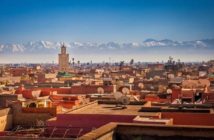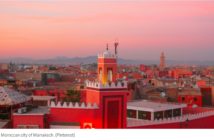
1/2
By Fiona Duncan
Marrakesh’s current building boom is great news for those in search of somewhere special to stay. Fiona Duncan reviews eight of her favourite new or renovated hotels.
A bird’s-eye view can be so instructive. Drifting in a hot-air balloon over a yellow and green landscape flecked with palm trees, olive groves, brown knots of Berber villages and, as we nearedMarrakesh, cranes and more and more new construction, I witnessed the massive increase in hotels, apartments and villas that Marrakesh is currently experiencing.
“Between 1990, when I first came here,” said our French pilot, Maurice “and the Millennium, there was almost no development; since then… it’s incredible to watch.” This Dubai-style expansion currently includes 19 new hotels due to open by the end of 2012 and comes hand in hand with young King Mohammed VI’s avowed goal of attracting 20 million tourists a year to Morocco by 2020 (currently there are just under 10 million).
But even if such goals prove to be too ambitious, Marrakesh continues to work well for holidaymakers. Though it lacks world-class sights – apart from Djemma el Fna, the magical, pulsating central square that comes alive at sunset with storytellers, musicians, snake-charmers and food stalls – its climate is hot and dry and it’s only three hours’ flight from London, with one hour’s time change.
Until the recent building boom, most visitors stayed in one of the dozens of riads in the medina. But now many holidaymakers are opting instead for a hotel a little farther away, with more space and facilities than the traditional riads, making forays to the medina by day. The upmarket chains – including Four Seasons, Sofitel and Mandarin Oriental – are increasingly on the scene, but plenty of smaller, less expensive, privately owned properties are also on offer. So here is my pick of the most interesting newcomers.
PALAIS NAMASKAR
Opened in April, this serene retreat, set in 15 acres of scented, Balinese-style water gardens between the Atlas Mountains and the mysterious Djebilet Hills, has a palpable, intensely soothing effect. Its 41 rooms, suites and villas are hardly visible amid the palms, exotic foliage, emerald lawns and bowers of white bougainvillea, all interspersed with four acres of water – pools, channels, lakes and waterfalls.
With a seductive spa and a rooftop terrace – wonderful at sunset – the hotel is designed as an exercise in the principles of feng shui. Thus, you will find a balance of wood (Balinese), fire (in every room), earth, metal and water, as well as an entire floor of “energy-releasing crystals” and the same dark silk curtains – more than four miles of material – throughout. At first I worried about such uniformity, but though anodyne, the deliberate repetition somehow does help one to unwind.
Especially appealing are the Pool Suites, whose heated swimming pools, surrounded by billowing curtains for extra privacy, are each embedded in an elegant communal lake, while the suites themselves also have walled gardens, glass bathrooms surrounded by greenery and spacious sitting rooms (with domineering televisions, though they can be removed).
At night, the combination of candlelight, moonlight and pillars and arches reflected in water transforms Palais Namaskar into something magical and romantic. The contemporary French food is appropriately light and inventive (route de Bab Atlas; 00212 524 299800;palaisnamaskar.com; doubles from £316).
KASBAH BAB OURIKA
Though just 45 minutes from the city, Bab Ourika allows a combination of comfort and contact with the “real” Morocco more readily than any other Marrakesh hotel. Reaching this eyrie in the foothills of the Atlas, its traditional “rammed earth” walls surrounding a rose-filled courtyard, means bumping at snail’s pace along a narrow track but once there, you are rewarded with astonishing views.
Some come here to hike, rock climb, horse ride or kayak, others to flop with a good book supplied by the hotel on the gorgeous terrace or by the pool, set in luxuriant gardens that, like the house, feel far more mature than their handful of years. Both the bedrooms and the home-grown food display have an unpretentious stylishness that perfectly matches their surroundings.
Try to be there on a Monday, when Mohammed will accompany you on foot to the colourful Berber market in the lush Ourika river valley below, then to his home for lunch (Tnine Ourika; 668 749547;kasbahbabourika.com; doubles from £122).
![]()
SELMAN
“One man’s dream” is a phrase that can be applied to countless hotels. In the case of the just-opened Selman, the delightful dreamer, born with a silver spoon but determined to prove himself, was so young, just 24, that his chosen designer, the celebrated Jacques Garcia, walked straight past him at their first meeting.
Five years on, Abdeslam Bennani Smirés’s singular idea – to embellish a luxury hotel with the pure Arab horses that he breeds in Rabat – has come to fruition. At the heart of Garcia’s concept for Selman – he is both designer and architect – is a 260ft runway of a swimming pool flanked by sunlit terraces, inter-spersed with paddocks in which a dozen of these beautiful animals graze in full view of guests.
Inside the hotel – built of mellow, handmade brick – lofty, opulent, shadowy spaces, lit by jewel-like lamps and cascading chandeliers, flow one into another so that guests feel equally at home dining or reading a book. All 56 generous rooms and suites overlook the pool and paddocks, and though this makes for overlong corridors, young Abdeslam has, I hope, succeeded in giving yet another luxury Marrakesh hotel (and its fabulous Dominique Chenot spa) a clever and attention-grabbing twist (route d’Amezmiz; 524 459600;selman-marrakech.com; doubles from £290).
BELDI COUNTRY CLUB
An oasis. A magical garden less than four miles from the city where the longer you stay, the more delights you discover. Much of Beldi’s appeal lies in the fact that over the past few years it has grown organically out of an old olive grove that Jean-Dominique Leymarie bought to escape the crowded medina, where he lives.
With beguiling flair, he first conjured an outdoor restaurant and pool, then a shady spa, cavernous rooms piled with Berber rugs and linens for sale, a bakery and a pottery, with classes for children, a pavilion for musical evenings and, most recently, 28 hotel rooms. All are embedded, half-hidden, in 12 acres of lush, imaginative gardens that include a field of more than 1,300 roses, hedges of hibiscus, dividing walls made of huge urns, and swathes of tall, soft grasses, among which bright red deckchairs peek out.
The tucked-away, country- chic bedrooms, many with log fires, are all different, grouped together around courtyards, with roof terraces, or found down a maze of Berber-style alleys, with gardens. The French/Moroccan food is simple and satisfying, the clientele elegant and laid-back. Jean-Dominique’s son and daughter now run Beldi with a benign touch, touring their pleasure garden on bicycles (route d’Amezmiz; 679 892607; beldicountryclub.com; doubles £134).
![]()
SIRAYANE
Though it didn’t beguile me in the same way as the other new hotels described here, Sirayane, 10 minutes’ drive from the medina, is probably the most successful of them all, having quickly become popular with couples, families and well-known “personalities” for its contemporary looks and above-average facilities (including suites with their own pools) at very attractive rates.
Designed in a bold, uncompromising cubist style by the Philippe Starck protégé Imaad Rahmouni (also responsible for Palais Namaskar), it has a palette that is predominantly soft grey, and rooms grouped around two central swimming pools.
The hotel serves excellent, well-priced food, has a good spa and – unusually – a free shuttle that runs all day until 11.15pm to and from Marrakesh. Rates fluctuate: book early for best prices (route d’Amezmiz; 525 118880; sirayane.com; doubles from £130).
ROYAL MANSOUR
Royal palace meets Disney World. It all begins so well in this extraordinary hotel, built by the present King Mohammed as a celebration of the finest Moroccan arts and crafts, and costing a sum that to this day no one knows.
The public rooms are exquisite, handmade in precious materials by 1,200 craftsmen, with captivating vistas at every turn, and the building has the air and grace (but none of the pomposity) of an authentic palace, if one that feels strangely deserted, save for statue-like attendants and the odd guest.
Then, for those who are staying, it’s out into the hotel’s equally quiet “medina” and to one of 52 three-storey riads, which are equally beautiful but somewhat dark and claustrophobic. And tiring – I know, to my cost – when you are on your rooftop terrace, and you’ve left your sunglasses 63 steps below in the ground-floor sitting room. And deflating, when you peek through a door to reveal a backstage network of corridors and lifts specially created so that staff can remain unseen while going about their work, theme-park style (rue Abou Abbas El Sebti; 529 808080;royalmansour.com; doubles from £1,131).
LA MAMOUNIA
When it reopened after a three-year renovation, this celebrated address, between the city centre and the medina, revealed a dramatic new look, courtesy of Jacques Garcia. Whether you warm to Garcia’s classic yet darkly theatrical interiors or not, it’s La Mamounia’s 20 acres of impeccable gardens, huge, curvaceous swimming pool and gorgeous new spa that are its real assets.
If your budget isn’t up to staying, then you can take advantage of the hotel’s day pass, which includes use of the pools, tennis courts and gym, plus lunch (£86).
An unusual offer from a top hotel? “Just as you might treat yourself to a Dior scent but not the couture, so you can enjoy at least a whiff of life at La Mamounia with our day pass,” I was told (avenue Bab Jdid; 524 388600; mamounia.com; doubles from £456).
![]()
RIAD JOYA
With so many upmarket hotels in and around Marrakesh competing for custom, quality of service becomes a major distinguishing feature. And for all the immaculately dressed attendants and white-gloved waiters on hand at hotels such as Royal Mansour and La Mamounia, few can compete with the warm yet dignified, enveloping yet practical hospitality offered in a really good riad.
One such is the new seven-suite Riad Joya, in the heart of the medina, where manager Khalid and chef Mehdi and their staff are able to define what it is to be looked after in a hectic, confusing foreign city. Between them they will feed you when you want, give you advice when you want and organise your days if you want.
As for the riad itself, found down a crumbling alley close to Djemma el Fna, it’s impeccably decorated in discreet Milan-meets-Morocco style and exudes, with its pale colours, floating curtains and beautifully designed furniture, a sense of ethereal calm, broken only by the call to prayer from the mosque next door. It’s also affordable, and prices include private airport transfers. (Hay Mouassine;524 391624; riadjoya.com; doubles from £144).
DID YOU KNOW?
The name Marrakesh is thought to derive from mur akush, which means Land of God in Berber.
WHAT TO AVOID
Getting exasperated by souk hasslers. Try saying firmly “respectez-moi, s’il vous plaît” when they become too much.
Avoid mistaking fakes for authenticity. For authentic shopping, visit Berber artisans in a fondouk (centuries-old courtyard workshops) such as those in rue dar el Bacha.
Avoid the tanneries: remote medina location; bad smell; hard sell.
RELATED ARTICLES
.






